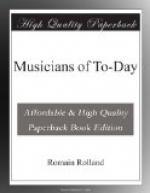For several years the leader of the young school, M. Claude Debussy, has, in his writings in the Revue Blanche and Gil Blas, attacked Wagnerian art. His personality is very French—capricious, poetic, and spirituelle, full of lively intelligence, heedless, independent, scattering new ideas, giving vent to paradoxical caprice, criticising the opinions of centuries with the teasing impertinence of a little street boy, attacking great heroes of music like Gluck, Wagner, and Beethoven, upholding only Bach, Mozart, and Weber, and loudly professing his preference for the old French masters of the eighteenth century. But in spite of this he is bringing back to French music its true nature and its forgotten ideals—its clearness, its elegant simplicity, its naturalness, and especially its grace and plastic beauty. He wishes music to free itself from all literary and philosophic pretensions, which have burdened German music in the nineteenth century (and perhaps have always done so); he wishes music to get away from the rhetoric which has been handed down to us through the centuries, from its heavy construction and precise orderliness, from its harmonic and rhythmic formulas, and the exercises of oratorical embroidery. He wishes that all about it shall be painting and poetry; that it shall explain its true feeling in a clear and direct way; and that melody, harmony, and rhythm shall develop broadly along the lines of inner laws, and not after the pretended laws of some intellectual arrangement. And he himself preaches by example in his Pelleas et Melisande, and breaks with all the principles of the Bayreuth drama, and gives us the model of the new art of his dreams. And on all sides discerning and well-informed critics, such as M. Pierre Lalo of Le Temps, M. Louis Laloy of the Revue Musicale and the Mercure Musicale, and M. Marnold of Le Mercure de France, have championed his doctrines and his art. Even the Schola Cantorum, whose eclectic and archaic spirit is very different from that of Debussy, seemed at first to be drawn into the same current of thought; and this school which had so helped to propagate the foreign influences of the past, did not seem to be quite insensible to the nationalistic preoccupation of the last few years. So the Schola devoted itself more and more—as was moreover its right and duty—to the French music of the past, and filled its concert programmes with French works of the seventeenth and eighteenth centuries—with Marc Antoine Charpentier, Du Mont, Leclair, Clerambault, Couperin, and the French primitive composers for the organ, the harpsichord, and the violin; and with the works of dramatic composers, especially of the great Rameau, who, after a period of complete oblivion, suddenly benefited by this excessive reaction, to the detriment of Gluck, whom the young critics, following M. Debussy’s example, severely abused.[258] There was even a moment when the Schola took a decided share in the battle, and, through M. Charles Bordes, issued a manifesto—Credo, as they called it—about a new art founded on the ancient traditions of French music:




